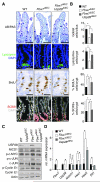Usp28 counteracts Fbw7 in intestinal homeostasis and cancer
- PMID: 25716680
- PMCID: PMC4384988
- DOI: 10.1158/0008-5472.CAN-14-1726
Usp28 counteracts Fbw7 in intestinal homeostasis and cancer
Abstract
The stability of several oncoproteins, including c-Myc, is regulated by ubiquitin-dependent degradation mediated by the SCF(Fbw7) ubiquitin ligase. This activity is antagonized by the deubiquitinase Usp28, which is highly expressed in murine and human intestinal cancers. Usp28 was previously shown to interact with its substrates via a "piggyback" interaction with Fbw7, which suggested that Fbw7 is required for Usp28 activity. Unexpectedly, we found that genetic deletion of Usp28 rescued the lethality of Fbw7-deficient primary fibroblasts. Moreover, Usp28 inactivation in the intestine (Usp28(ΔIEC)) ameliorated the hyperproliferation and the impaired goblet and Paneth cell differentiation observed in Fbw7(ΔIEC) mice. The aggressive intestinal tumor formation of APC(Min/+); Fbw7(ΔIEC) mice was restrained when Usp28 was inactivated concomitantly. In both fibroblasts and intestinal cells, Usp28 deficiency corrected the accumulation of SCF(Fbw7) substrate proteins, including NICD1, c-Jun, and c-Myc. These findings suggested that Usp28 function does not depend on the presence of Fbw7, but instead independently recognizes and deubiquitylates the same substrates as SCF(Fbw7). Fbw7 binds to a phosphorylated motif termed the phosphodegron and we found that Usp28 also interacted with this same motif, but only when it is unphosphorylated, offering a mechanistic explanation for identical substrate selection by Fbw7 and Usp28. Our results indicate an unusually direct antagonism between an E3 ligase and a deubiquitinase, Fbw7 and Usp28, in modulating intestinal homeostasis and cancer.
©2015 American Association for Cancer Research.
Figures




Similar articles
-
Dual regulation of Fbw7 function and oncogenic transformation by Usp28.Cell Rep. 2014 Nov 6;9(3):1099-109. doi: 10.1016/j.celrep.2014.09.057. Epub 2014 Oct 30. Cell Rep. 2014. PMID: 25437563
-
F-box and WD repeat domain-containing 7 regulates intestinal cell lineage commitment and is a haploinsufficient tumor suppressor.Gastroenterology. 2010 Sep;139(3):929-41. doi: 10.1053/j.gastro.2010.05.078. Epub 2010 Jun 2. Gastroenterology. 2010. PMID: 20638938
-
GSK-3β regulates cell growth, migration, and angiogenesis via Fbw7 and USP28-dependent degradation of HIF-1α.Blood. 2012 Feb 2;119(5):1292-301. doi: 10.1182/blood-2011-08-375014. Epub 2011 Dec 5. Blood. 2012. PMID: 22144179 Free PMC article.
-
Fbw7 and its counteracting forces in stem cells and cancer: Oncoproteins in the balance.Semin Cancer Biol. 2016 Feb;36:52-61. doi: 10.1016/j.semcancer.2015.09.006. Epub 2015 Sep 26. Semin Cancer Biol. 2016. PMID: 26410034 Review.
-
Physiological Functions of FBW7 in Metabolism.Horm Metab Res. 2022 May;54(5):280-287. doi: 10.1055/a-1816-8903. Epub 2022 May 9. Horm Metab Res. 2022. PMID: 35533672 Review.
Cited by
-
SENP1-mediated deSUMOylation of USP28 regulated HIF-1α accumulation and activation during hypoxia response.Cancer Cell Int. 2019 Jan 3;19:4. doi: 10.1186/s12935-018-0722-9. eCollection 2019. Cancer Cell Int. 2019. PMID: 30622440 Free PMC article.
-
Ubiquitin-specific proteases in inflammatory bowel disease-related signalling pathway regulation.Cell Death Dis. 2022 Feb 10;13(2):139. doi: 10.1038/s41419-022-04566-6. Cell Death Dis. 2022. PMID: 35145062 Free PMC article. Review.
-
Friend or foe? Reciprocal regulation between E3 ubiquitin ligases and deubiquitinases.Biochem Soc Trans. 2024 Feb 28;52(1):241-267. doi: 10.1042/BST20230454. Biochem Soc Trans. 2024. PMID: 38414432 Free PMC article. Review.
-
USP28 facilitates pancreatic cancer progression through activation of Wnt/β-catenin pathway via stabilising FOXM1.Cell Death Dis. 2021 Sep 28;12(10):887. doi: 10.1038/s41419-021-04163-z. Cell Death Dis. 2021. PMID: 34584067 Free PMC article.
-
Ubiquitin-specific protease 28 deubiquitinates TCF7L2 to govern the action of the Wnt signaling pathway in hepatic carcinoma.Cancer Sci. 2022 Oct;113(10):3463-3475. doi: 10.1111/cas.15509. Epub 2022 Aug 11. Cancer Sci. 2022. PMID: 35880246 Free PMC article.
References
-
- Welcker M, Clurman BE. FBW7 ubiquitin ligase: a tumour suppressor at the crossroads of cell division, growth and differentiation. Nature reviews Cancer. 2008;8:83–93. - PubMed
-
- Sancho R, Jandke A, Davis H, Diefenbacher ME, Tomlinson I, Behrens A. F-box and WD repeat domain-containing 7 regulates intestinal cell lineage commitment and is a haploinsufficient tumor suppressor. Gastroenterology. 2010;139:929–41. - PubMed
-
- Iwatsuki M, Mimori K, Ishii H, Yokobori T, Takatsuno Y, Sato T, et al. Loss of FBXW7, a cell cycle regulating gene, in colorectal cancer: clinical significance. International journal of cancer Journal international du cancer. 2010;126:1828–37. - PubMed
-
- Sansom OJ, Meniel VS, Muncan V, Phesse TJ, Wilkins JA, Reed KR, et al. Myc deletion rescues Apc deficiency in the small intestine. Nature. 2007;446:676–9. - PubMed
-
- Ignatenko NA, Holubec H, Besselsen DG, Blohm-Mangone KA, Padilla-Torres JL, Nagle RB, et al. Role of c-Myc in intestinal tumorigenesis of the ApcMin/+ mouse. Cancer biology & therapy. 2006;5:1658–64. - PubMed
Publication types
MeSH terms
Substances
Grants and funding
LinkOut - more resources
Full Text Sources
Other Literature Sources
Molecular Biology Databases
Miscellaneous

